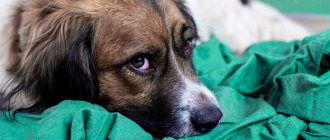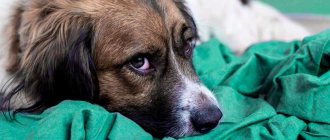Gastritis is an inflammation of the mucous membranes of the stomach. This pathology occurs quite often. Don’t worry too much; if you consult a specialist in a timely manner, the inflammation will go away very quickly.
If no measures are taken to improve the pet’s condition, the inflammation can spread further along the digestive tract. For example, gastroenteritis develops - inflammation of the mucous membranes of the stomach and intestines.
The causes of this disease are similar to those in humans, and among humans this disease occupies a leading place, so you have probably heard about it.
Causes of gastritis
In humans, the main cause of gastritis is the bacteria Helicobacter pylori, but in dogs there is no direct connection between the presence of these bacteria in the stomach and the development of inflammation.
The stomach of healthy animals is inhabited by Helicobacter - a wide range of acid-fast bacteria.
Inflammation of the stomach in dogs can develop for several reasons:
- Feeding disorders. This could be poor quality food, missing products, or simply “food from the table,” i.e. fried, smoked, fatty, etc.
- Food intolerance or allergy. Inflammation of the stomach is one of the consequences of these disorders in the body.
- Oral diseases/dental problems.
- Foreign bodies. This body could be a bone, or it could be something that is not even remotely edible. A foreign body can get stuck in the stomach itself and lower in the intestines. It (or they, if there are several of them) disrupts the patency of the digestive tract or can injure the gastric mucosa, which causes inflammation.
- Poisoning with toxic substances.
- Infestation by parasites. Some helminths live just on the gastric mucosa. They stick to it, release toxins and irritate the walls of the organ.
- Viral infection.
The above factors directly affect the development of inflammation in the stomach, but there are also secondary causes - diseases of a different nature (sometimes of completely different organs and systems), which one way or another can cause gastritis:
- Infectious diseases.
- Liver or kidney diseases.
- Stress.
- Injury.
- Hormonal disorders, such as hyperadrenocorticism or diabetes mellitus.
Signs of the disease
Gastritis has no specific signs, which can complicate the diagnosis. In some cases, poisoning can be suspected - if the pet refuses to eat, he experiences vomiting and diarrhea.
Discomfort in the stomach is the first manifestation of the disease. The inflammatory process forces the dog to refuse food - because every piece that enters the stomach causes irritation of the mucous membrane and causes pain. The animal may behave restlessly and whine, or, on the contrary, falls into apathy and tries to lie down more so that movements do not cause a new attack of pain. These are important “bells” that require the owner to take the pet to the veterinarian.
When a dog develops pain and cramping in the stomach, it does not allow its belly to be stroked, and may even show aggression. The pain may be constant or intermittent. The dog loses interest even in its favorite treats, and after eating, vomiting appears: particles of undigested food can be seen in the vomit. A dangerous symptom is the presence of bile and blood clots in it. This indicates a severe form of gastritis.
With acute gastritis, the dog’s body temperature may increase, while chronic gastritis occurs without any change. A white coating can be observed on the tongue, and a specific unpleasant odor comes from the mouth. The mucous membranes of the oral cavity acquire a pale, even jaundiced tint, and the fur becomes dull. All symptoms indicate poor health of the animal, and a visit to the veterinarian cannot be postponed even at their first manifestations.
Symptoms
No matter what causes the inflammation of the gastric mucosa, if the process is acute, the symptoms are always similar.
The pain is usually not that severe. The first thing owners notice:
- Vomit. Usually it occurs suddenly, maybe with an admixture of bile or mucus, or even less often with an admixture of blood (due to bleeding in the stomach).
- Diarrhea. It may also be mixed with blood due to stomach bleeding.
- Conversely, there may be constipation. If the stool is dark, it means there is blood in it.
- General depression.
- Lack of appetite (not always, but may be the only sign!).
- When palpating the abdominal wall in the stomach area, the dog experiences pain. She herself will not tell you this, you can understand it by her behavior. She may start to growl or whine, depending on the animal's temperament. Even if your dog is silent like a guerrilla, pain can be recognized by the tension in the abdominal wall.
- Vomiting often occurs in the morning or immediately after eating, depending on whether the acidity in the stomach is high or low.
Gastric volvulus as a concomitant pathology
Stable expansion of a full stomach is fraught with twisting. This pathology is accompanied by:
- severe anxiety;
- ineffective vomiting;
- increased salivation;
- bloating.
The only way to treat bloat is surgery. When visiting a veterinary clinic late, the likelihood of death from circulatory disorders and shock increases.
Diagnostics
Gastritis is an easy disease to diagnose and treat. If you take the necessary measures in time.
The cause of the developed inflammation cannot always be determined, but this is not particularly important, except in cases of parasites or a foreign body.
Since the mild stage of gastritis is treated symptomatically, the primary diagnosis can be based on anamnesis (data about life, feeding, treatments and vaccinations, which the doctor learns from the owner) and on a physical examination.
Physical examination includes external examination of the animal, palpation and auscultation of the painful area.
If, based on the data obtained, the veterinarian does not see signs of systemic diseases and there is no severe abdominal (abdominal) pain, signs of obstruction or the presence of a foreign body, and he suspects gastritis, then symptomatic therapy and a special diet are prescribed. Often this is enough for the stomach to return to normal.
If after 2 days of such therapy the pet’s condition does not improve, it is necessary to conduct a full comprehensive examination in order to prescribe a full-fledged high-quality treatment!
For a high-quality diagnosis, the dog must endure a starvation diet. In situations where the dog has not eaten for more than two days, he is prescribed maintenance therapy in the form of nutritional drips.
If a foreign body or obstruction is suspected, they are sent for an X-ray with contrast (preliminary barium is removed).
Next, blood and urine are taken for laboratory tests.
If necessary, ultrasound diagnostics of the abdominal cavity is performed.
The most informative research method is gastroscopy. It is carried out using a special device - an endoscope. Unfortunately, it is not available in all veterinary clinics. If you don’t go into details, then with its help it is possible to directly see the changes occurring in the stomach and even remove some small tumors.
Stomach diseases of dogs and cats
The stomach in cats and dogs is an independent organ that is part of the digestive tract. Like any organ, the stomach is susceptible to specific diseases, each of which has its own name, etiology and pathogenesis. One of the most important tasks of a clinician faced with a stomach disease is to determine which particular nosological unit he is dealing with, since both the diagnostic plan and the tactics of further treatment depend on this.
Typically, gastric disease results from inflammation, ulceration, neoplasia, or obstruction. The clinical manifestations of stomach diseases are similar: most often it is vomiting and/or retching, hematemesis, melena, belching, hypersalivation, abdominal discomfort, weight loss (in chronic diseases). Gastritis, which will be discussed in this material, is only a part of the many diseases associated directly with the stomach. Most often, veterinarians deal with the following stomach pathologies:
- inflammation (gastritis)
- acute dilatation
- volvulus
- erosions and ulcers
- neoplasia
- motor disorders
Gastritis is one of the most frequently diagnosed diagnoses when a patient is admitted with a complaint of acute or chronic vomiting. Meanwhile, acute/chronic vomiting syndrome is extremely common in small animals and in the vast majority of cases has many other causes. A clear understanding of the cases in which the diagnosis of “gastritis” is legitimate is necessary. In addition, since acute/chronic vomiting syndrome can occur for a variety of reasons, and making a diagnosis in this case is not an easy task, it is very important to follow a generally accepted diagnostic plan to avoid errors in diagnosis and, subsequently, in the treatment of the patient.
Stomach - structure and functions.
The stomach consists of 4 functional sections: cardia, fundus, body and antrum.
- the cardiac section is responsible for controlling the flow of food from the esophagus into the stomach (and the esophageal sphincter prevents it from flowing back into the esophagus)
- the body and fundus of the stomach have a high ability to stretch (ingesting a large volume of food)
- the antrum has a thicker muscle wall (grinding and homogenization of the food mass before entering the intestine)
- The pyloric sphincter controls the flow of chyme into the intestines
The histological structure of the stomach corresponds to that of any tubular organ (see diagram below). The gastric epithelium is secretory and produces both a protective buffer for the mucous membrane and digestive enzymes (the type of secretion depends on the location of the epithelium in the sections of the stomach).
Schematic diagram of the structure of a tubular organ, from the site https://www.vetmed.vt.edu
The author recommends this online resource as a real storehouse of educational information with very accessible explanations, drawings and microphotographs
Digestion of nutrients.
Gastric juice helps begin the digestion of proteins (pepsin) and fats (gastric lipase), and also stimulates gastric emptying and stimulation of the secretory function of the pancreas. In addition, gastric acid limits the proliferation of gastrointestinal microflora. It is noteworthy that gastric lipase remains active in the small intestine and accounts for up to 30% of total lipase in dogs.
The stomach is protected from gastric acid by the BSG - a barrier of the gastric mucosa. This concept includes a dense epithelial layer, secreted bicarbonate mucus, local production of prostaglandins and rapid repair of the epithelium in case of damage.
Microflora of the stomach.
The stomachs of dogs and cats are constantly inhabited by Helicobacter spp. These are acid-tolerant microorganisms that produce urease to create a buffer that protects them from acid. Some other bacteria (Proteus, Streptococcus, etc.) may be temporarily present, but normally acid secretion and normal peristalsis successfully regulate their numbers. Therefore, with a decrease in the secretory function of the mucosa, proliferation of these microorganisms may be observed. The role of Helicobacter in the development of inflammation and mucosal atrophy in cats and dogs is debated.
The diagnosis of “gastritis” is one of the most common diagnoses made by veterinarians for animals whose owners complain of acute or chronic vomiting. Meanwhile, the syndrome of acute (chronic) vomiting is not always associated directly with the gastrointestinal tract, and stomach diseases are not only gastritis. In addition to inflammatory causes, stomach diseases can be associated with a number of others. In foreign literature, stomach diseases are usually divided according to their etiology and pathogenetic mechanism:
- inflammation
- infectious (invasive) causes (infection)
- diseases associated with obstruction
- diseases associated with impaired motor skills (dysmotility)
- oncological diseases (neoplasia)
- erosive and ulcerative lesions (ulcer)
In this article we will consider only one group of diseases united by inflammation as the main pathogenetic mechanism of development.
Acute gastritis.
Acute gastritis is the term used to define the syndrome of sudden onset of vomiting. Most often, the cause of the condition can be determined by questioning the owner in detail. Damage to the gastric mucosa with subsequent inflammation can occur either through direct contact with a damaging substance (in this case we are talking about primary acute gastritis), or due to indirect damage associated with diseases of other organ systems (secondary gastritis, a striking example is uremic gastropathy in chronic renal failure).
Clinical signs.
The main clinical sign is sudden onset of vomiting. It is important to remember that sometimes anorexia may be the only clinical sign (as a consequence of nausea) in acute gastritis. The general condition of the animal is most often satisfactory; there may be a decrease in appetite and activity. If acute gastritis is associated with the ingestion of foreign bodies, toxins, systemic disorders, there is often an admixture of blood in the vomit, feces, concomitant diarrhea, and a significant deterioration in the general condition. Such patients require a more thorough diagnostic approach.
Diagnostics.
Based on anamnestic data, clinical manifestations and response to symptomatic treatment. If there is no evidence of systemic disease, diagnostic testing is usually not necessary. However, it is necessary to begin the examination immediately if:
- there are signs of a systemic disease;
- there is a significant deterioration in general condition;
- in addition to vomiting, there is diarrhea, abdominal pain, blood in the vomit and/or stool
- fever is present
- history of eating foreign objects, toxic substances;
- no response to symptomatic therapy within 1-2 days.
The basic diagnostic profile in these situations includes:
- general clinical and biochemical blood test, stool test for parasites (flotation method), urine test
- X-ray examination (with and/or without contrast)
- Ultrasound
- endoscopy
Additional studies may be included in the examination protocol based on the results of basic tests (PCR for infections, bile acid test, test for specific pancreatic lipase, etc.)
Treatment.
For uncomplicated acute gastritis, treatment is most often symptomatic. If the cause of the condition is known, the first step is to eliminate it, if possible.
Diet therapy.
It is advisable to provide “rest” to an inflamed stomach. Its duration depends on the age of the animal and the severity of gastritis. The fasting diet should not be too long, since the flow of food into the gastrointestinal tract maintains its barrier function. Usually for uncomplicated gastritis it is 12-24 hours. The inflamed mucous membrane reacts to stretching, so to avoid resumption of vomiting, portions of water and food should be as small as possible. The main goals are to avoid stretching the stomach walls and minimally stimulate acid secretion. It is known that among protein sources, the most active secretion stimulator is animal protein, and vegetable and milk proteins stimulate acid production the least. Therefore, when choosing a diet for a patient who is on a natural diet, it is worth choosing low-fat cottage cheese and rice in a ratio of 1:3. Of the ready-made diets, the best options are those containing soy hydrolysate as the only source of protein (for example, Purina® HA), or easily digestible therapeutic diets with a low protein content for animals with gastrointestinal diseases (for example, Purina® EN).
Infusion therapy.
In uncomplicated acute gastritis, fluid loss is rarely significant, although in small animals repeated vomiting can cause dehydration. If the fluid deficit is less than 5%, subcutaneous administration of isotonic solutions is effective. If significant dehydration occurs, intravenous infusions are required and such animals should be monitored and examined more closely.
Gastroprotectors.
Drugs in this group are prescribed for gastritis to protect the gastric mucosa, as well as to bind bacterial toxins and the bacteria themselves. The drugs of choice are:
- sucralfate (dogs 1 g/30kg every 8-12 hours, 30-60 minutes before feeding, cats 250 mg/cat); You can prepare a suspension from the tablet form and drink it, this is considered more effective.
- Bismuth preparations: have a cytoprotective effect and are also active against Helicobacter bacteria. Long-term use should be avoided due to possible adsorption of bismuth salts.
H2-blockers and antibiotics: it is advisable to prescribe them in case of signs of erosive damage to the gastric mucosa (hematemesis, melena), as well as in chronic gastritis. For acute uncomplicated gastritis, they are usually not necessary.
Antiemetics.
The prescription of antiemetic drugs for acute gastritis is justified only in cases where intense repeated vomiting leads to significant dehydration and significantly worsens the animal’s condition. In other cases, it is worth trying not to prescribe antiemetic drugs in order to assess the response to symptomatic treatment (diet therapy + gastroprotectors). If vomiting continues, antiemetics are included in the treatment protocol and the diagnostic plan is revised. Drugs of choice:
- maropitant 0.1 ml/kg once a day; in addition to a powerful antiemetic effect, it significantly reduces abdominal discomfort, which can significantly improve the patient’s general condition in a short time.
- metoclopramide 0.2-0.5 mg/kg every 8-12 hours; The antiemetic effect is weaker than that of maropitant, but its prokinetic effect suppresses gastroesophageal reflux and promotes gastric emptying.
Chronic gastritis.
This is a fairly common disease in dogs (found on average in 30-35% of dogs examined both for chronic vomiting and for other reasons; characteristic symptoms may not be expressed); There are no reliable studies on the incidence of chronic gastritis in cats. Important aspects:
- chronic gastritis is a histological diagnosis, that is, it can only be confirmed by histological examination of gastric biopsies;
- all possible causes of chronic vomiting must be excluded before a diagnosis of chronic gastritis can be made;
- If the diagnosis of chronic gastritis is confirmed histologically, it is necessary to try to find its cause before recognizing it as idiopathic. Most often, the cause can be identified.
The causes of chronic gastritis can be the same factors as in acute inflammation (see table). If these factors are absent, chronic gastritis is associated with food allergies or food intolerance, a hidden parasitic disease, a reaction to bacterial antigens (including the gastrointestinal tract's own microflora).
Gastritis in dogs and cats is classified by histopathologists according to the following histological changes:
- the predominant type of infiltrating cells (eosinophils, lymphocytes, plasma cells, etc.)
- structural changes (atrophy, hypertrophy, fibrosis, etc.)
- degree of severity – subjective (mild, moderate, severe)
Histopathological assessment of biopsies is not standardized for dogs and cats, so much depends on the experience and qualifications of the histopathologist. Care must be taken when selecting a laboratory to send samples to, as medical evaluation standards differ significantly from those for animals, and it is not uncommon to receive confusing results when relying on the opinions of medical professionals.
The most common type is superficial lymphoplasmacytic gastritis of mild or moderate severity with concomitant lymphoid follicular hyperplasia .
Photo from https://scialert.net
Picture of chronic lymphoplasmacytic gastritis. Wide arrows indicate areas of lymphoid follicular hyperplasia
Clinical symptoms.
The main symptom is chronic vomiting of food or bile. There may be periods of spontaneous improvement and worsening, or chronic vomiting may occur with the same frequency. Decreased appetite, weight loss, hematemesis, and sometimes melena may be present. Associated skin lesions and/or stool abnormalities increase the likelihood of a food allergy. Physical examination usually does not reveal any significant changes.
Diagnostics.
The results of standard laboratory tests (clinical and biochemical tests of blood, urine, X-ray examination, ultrasound), as a rule, do not have characteristic changes in chronic gastritis, but they should always be carried out to try to exclude systemic or metabolic or other problems not directly related to the stomach cause of chronic vomiting. Detected eosinophilia may indicate the presence of gastritis associated with parasites or food allergies, mastocytoma. Panhypoproteinemia is observed in generalized IBD (IBD), gastrointestinal lymphoma, and Norwegian Lundehund gastroenteropathy. High levels of globulin and low levels of albumin can be observed in Basenjis with gastroenteropathy characteristic of this breed.
Endoscopic examination with biopsy samples.
It is a key study for the final diagnosis of chronic gastritis. Biopsy samples should be taken even when macroscopic assessment of the mucous membrane does not reveal visual changes. The result of histological examination is extremely important from the point of view of choosing treatment tactics, since with different degrees of severity of the same form of gastritis, different treatment regimens will be used.
Idiopathic chronic gastritis
If all possible systemic/metabolic/endocrine causes of gastritis have been excluded at the stage of the standard examination protocol, chronic gastritis, confirmed histologically, is recognized as an idiopathic form (that is, a disease whose etiology is not clear). The most common type of idiopathic chronic gastritis in cats and dogs is mild to moderate lymphocytic-plasmacytic gastritis. This term means that the gastric mucosa is infiltrated (“impregnated”) with inflammatory cells – lymphocytes and plasmacytes. This process may be accompanied by atrophy and fibrosis of the mucosa, and less often by hyperplasia.
Mild lymphoplasmacytic gastritis.
The most common option, and the first stage of treatment, usually involves prescribing an elimination diet containing a new source of protein for the animal. If the patient receives a natural diet, the diets recommended for dermatological patients (fish and potatoes for dogs, pork or horse meat for cats) can be used as the basis for therapeutic feeding. The diet of animals kept on ready-made diets is easier to adjust. For dogs, you can use Purina® Veterinary Diets DRM, which contains capelin as the main protein source, or Purina® Veterinary Diets HA, which contains hydrolyzed soy protein as the only protein source. For cats, the NA diet for cats is suitable.
In addition to being a preferred source of protein, these diets also contain sufficient amounts of polyunsaturated fatty acids and antioxidants, which are likely to reduce mucosal inflammation. Sufficient carbohydrate and fiber content will contribute to timely emptying of the stomach.
In gastroenterology, an elimination diet is prescribed, in contrast to dermatological regimens, for 2 weeks - this is how long it takes to evaluate its effectiveness, in addition, this is usually the maximum period that the patient’s owner agrees to. If the diet has proven to be effective, challenge tests with components of the original diet can be performed to identify the product causing vomiting. Practice shows that owners often refuse provocative tests, in which case the patient can be left on an elimination diet. You can try another diet option if the first one turns out to be ineffective, but most often in these cases you have to switch to drug therapy, since vomiting that continues despite the treatment started bothers both the patient and its owner. The drug of choice is prednisolone, it is prescribed orally at a dose of 1-2 mg/kg 1 time per day, after vomiting stops, the dose is reduced to 1 time per 48 hours, then the dose is gradually reduced to the lowest level that maintains remission (the dose is reduced until vomiting starts again , then you need to return to the previous effective dose and stay on it for about 8-12 weeks).
Moderate to severe lymphoplasmacytic gastritis.
Treatment with prednisone begins immediately, always combining it with an elimination diet. After vomiting stops, the dose of prednisolone is reduced, as in the previous case, and the diet is left for as long as possible. Moderate and severe degrees of LPG are often combined with the formation of erosions and even ulcerations of the mucous membrane; in these cases, gastroprotectors and H2 blockers are included in the treatment regimen:
- orally Sucralfate 1 g/30 kg one hour before feeding to dogs 2-3 times a day, 250 mg/cat in the same regimen;
- orally, intravenously Famotidine 0.1-0.5 mg/kg 2 times a day.
Long-term administration of antisecretory drugs (H2-blockers, proton pump inhibitors) should be avoided, since in this case excessive growth of gastric flora is possible, as well as the development of hypertrophic gastritis (not yet confirmed in cats and dogs).
If there is no improvement with diet, prednisolone and gastroprotectors, you should reconsider the diagnosis before starting more aggressive immunosuppressive therapy and make sure that all metabolic/systemic/endocrine causes of the development of chronic gastritis are excluded.
If it is still necessary to use drugs with a more pronounced immunosuppressive effect, or if the patient has a significant side effect of prednisolone, the drug of choice for dogs is azathioprine (orally 2 mg/kg once a day for 5 days, then alternates with prednisolone, azathioprine for 1 day , 1 day prednisolone). For cats, the drug of choice is chlorambucil at a dose of 0.25 mg/kg every 24-48 hours.
Eosinophilic gastritis.
Clinical signs are similar to those of lymphoplasmacytic gastritis; histologically manifested in infiltration of the gastric mucosa by eosinophils (or eosinophils will predominate in the cellular infiltrate). Most often, this type of gastritis is associated with hypersensitivity to food components or with endoparasitosis, therefore, before starting immunosuppressive therapy, it is necessary to carry out deworming, even if parasites were not detected in fecal samples. In general, treatment tactics for eosinophilic gastritis are identical: elimination diet, immunosuppressants, gastroprotective agents for moderate and severe inflammation.
Other forms of chronic gastritis (histiocytic, atrophic, hypertrophic, etc.) are rare in cats and dogs and are most often associated either with specific lesions (for example, infection with a fungus of the genus Pythium in histiocytic/granulomatous gastritis), or with a breed predisposition to certain gastropathy (for example, hypertrophy of the antral mucosa in dogs of brachycephalic breeds - Lhasa Apso, etc. This can lead to obstruction of the pyloric part of the stomach and requires surgical correction)
From the site https://www.familyvet.com
Hypertrophic gastritis and pyloric hypertrophy of the mucosa in brachycephalic dogs.
Summary:
Gastritis in dogs and cats is a common disease.
Acute gastritis is the term that defines the syndrome of acute vomiting. Primary uncomplicated acute gastritis is a diagnosis made on the basis of anamnestic data, physical examination and response to symptomatic treatment; examination is usually not required. The prognosis is favorable.
Chronic gastritis is largely a histological diagnosis, which can only be confirmed by histopathological examination of gastric biopsies.
Careful exclusion of possible systemic/metabolic/endocrine causes is necessary before chronic gastritis can be considered idiopathic. Often the root cause is found, and in some cases it can be eliminated.
It is not possible to establish the cause of the idiopathic form of chronic gastritis; treatment tactics are based on the premise that this is an immune-mediated process. The prognosis of the disease depends on the severity and response to specific therapy.
Article on our Yandex Zen channel.
Types of gastritis
Inflammation in the stomach can be acute or chronic.
Acute gastritis is characterized by sudden severe vomiting and rapid development with increasing pain.
Chronic gastritis is a consequence of the acute stage. Usually in such cases, periodic vomiting continues for more than a week and then significant weight loss becomes noticeable.
According to the form they are distinguished:
- Erosive ulcerative gastritis. This form differs in that ulcers form on the gastric mucosa.
- Eosinophilic, lymphoplasmacytic and granulomatous gastritis - these forms are not clinically distinguished; they are differentiated only on the basis of histological (tissue) analysis. They are characterized by thickening of the stomach wall and increased levels of eosinophils. Usually caused by a parasitic infestation or an allergic reaction/food intolerance.
- Atrophic gastritis (it occurs chronically) is characterized by thinning of the walls of the stomach and atrophy of the gastric glands.
- Separately, it is worth highlighting chronic hypertrophic gastropathy . This form of pathology leads to disruption of gastric outflow and is characterized by severe vomiting immediately after eating for several days.
Treatment
- First of all, if the cause of inflammation is established, then it must be eliminated. For example, if gastritis is caused by any drug, then under the supervision of a veterinarian you need to stop it (and prescribe a harmless analogue). If the cause is helminthic infestation, then it is worth deworming.
- Next, the pet is prescribed a starvation diet for several hours so that the gastrointestinal tract “rests.”
- Resume feeding gradually. They give food often, but in small portions.
- It is very important to change feeding. We are not returning the previous diet. The veterinarian must prescribe a special diet.
- If necessary, infusion therapy is prescribed (droppers or subcutaneous administration of drugs). This is necessary if the animal is dehydrated.
- Next, at the doctor’s discretion, gastroprotectors are prescribed (most often sucralfate). They may also prescribe medications that stimulate peristalsis (stomach motility).
- In some cases, prednisolone is prescribed (here you need to be very careful with the dosage; you should not give it without the supervision of a veterinarian).
- The duration of treatment depends on the severity of the disease.
In any case, you need to understand that if a dog has once been diagnosed with gastritis, most likely the tendency to it will haunt the dog for the rest of its life. So be careful about feeding your pet.
All medications must be prescribed by a specialist; you should not resort to self-medication.
Consequences and forecasts
Most often, complications arise in the chronic form, as it is always accompanied by relapses. Possible consequences include:
- tooth loss;
- alopecia;
- gastric hemorrhage;
- development of ulcers;
- deterioration of hearing and vision;
- intestinal obstruction;
- volvulus of the stomach.
Despite this, most cases of gastritis in dogs are treatable. An unfavorable prognosis is typical only in the presence of renal failure, as well as in the eosinophilic and lymphoplasmacytic varieties.
Diet for gastritis
It all depends on whether you feed your dog natural food or dry food. When choosing dry food, you should pay attention to the Gastro medicinal line. Royal Canin has such lines.
If your dog sits on a natural bed, it will be more difficult. Ideally, you need to contact a veterinary nutritionist so that he can create a balanced therapeutic diet specifically for your pet.
If this is not possible, then the main thing is to adhere to several rules:
- Eliminate all fatty meats. It is better to leave only rabbit or turkey meat.
- Cook porridge separately from meat.
- Do not give your dog meat broth - it is too fatty.
A good option would be boiled rice with low-fat cottage cheese. However, not every dog will agree to eat it.
Basic principles of a therapeutic diet
Treatment is not complete without diet. Depending on the form of gastritis in the dog, the doctor decides what to feed it until it recovers. In case of chronic pathology, the diet must be adhered to throughout life.
Diet in acute form
The pet is deprived of any food for a day, and then gradually transferred to fractional meals. Before serving, all food is ground or mashed to a puree consistency. Dry granules are soaked in warm water or replaced with wet canned food. They begin to return to the usual menu on the 3-4th day, adding small pieces of meat to slimy porridges and starchy foods.
Diet for chronic form
Fasting is not practiced. The diet is less strict than in the acute form. The consumption of difficult-to-digest foods is excluded, but animal protein in the form of scrambled eggs and grated cheese is encouraged. All food is served boiled or stewed 3-5 times a day. Additional restrictions are imposed only if a relapse occurs.
Prohibited Products
The prohibited list includes any dishes from the human table and some products
:
- fatty meats and fish, as well as broths based on them;
- eggs (except egg white omelet);
- dry food;
- large bones;
- milk;
- sorrel, white cabbage, peas, turnips, mushrooms, garlic and onions;
- salty and spicy cheeses;
- fermented milk products with high fat content;
- millet, pearl barley and corn porridge;
- large bones.
Try to avoid overfeeding. Excessive production of gastric juice can aggravate the existing problem.
Allowed products and feed
Product safety is determined by pH level. If the value is low, it is recommended to eat bean puree, low-fat meat and fish broths, fermented milk products with low fat content, eggs and juices from beets or cabbage.
If the pH is higher than normal, then it is lowered to the desired value with watery porridges from rice and rolled oats, juices from carrots and potatoes, small pieces of lean boiled meat or fish.
When dry feeding, the animal is transferred to specialized food marked i/d. They reduce the load on the gastrointestinal tract and restore the intestinal microflora.
Prevention
Even if your dog is not included in the breed risk group, it is still important to prevent the development of gastritis. For this:
- The dog's diet must be balanced and consist of approved foods.
- Do not feed your pet “from the table”. Even if he asks. Find recipes for healthy dog treats or buy ready-made ones at a pet store if you want to please your pet.
- Annual vaccinations and periodic treatments against worms are the basis for the prevention of many diseases.
- It is important to monitor not only the correctness of the diet, but also the size of portions.
- Regular oral hygiene. Here we are not even talking about the fact that dogs also need to brush their teeth (which, of course, is very important). It is necessary to at least regularly examine your pet’s mouth, and if you notice any changes, such as inflammation of the gums, tooth loss or tartar formation, then you need to take the dog to the veterinary clinic for oral sanitation.
Don't forget that the mouth is part of the digestive tract.
How to reduce the likelihood of developing gastritis?
Remember that it is easier to avoid a disease than to cure it. Veterinarians have prepared several useful recommendations that will help avoid the development of gastritis in your pet. And the very first of them concerns the dog’s nutrition. To prevent stomach inflammation, select only high-quality food and do not give your pet food from the table.
Other prevention recommendations:
- Do not mix natural and industrial food. Decide what your pet’s diet will be, taking into account its individual characteristics.
- Keep a close eye on your dog while walking. She should not pick up unfamiliar objects or try to swallow them.
- Visit your veterinarian regularly. This is necessary for vaccination and anthelmintic therapy.
- Don't forget about hygiene procedures. An animal can bring pathogenic bacteria from the street onto its paws and fur.
- Never self-medicate or give medications from your home medicine cabinet. If you have any suspicious symptoms, contact your veterinarian.
Remember that the dog's health largely depends on your attention and care. Do not ignore the signs of gastritis - if you have any suspicions, contact a veterinary clinic and begin treatment!
Briefly about the main thing
Gastritis is a common inflammatory disease of the stomach.
- There are many reasons for the development of inflammation, both directly leading to gastritis and through other diseases. The most common: improper feeding, poisoning with toxins or other drugs, eating plants, allergies or food intolerances, helminthic infestations, viral infections, foreign body in the stomach, trauma, stress, genetic predisposition, gastritis can be immune-mediated.
- Main symptoms: refusal to eat and sudden vomiting.
- Diagnosis must be carried out in a veterinary clinic. The diagnosis is made based on the data that the animal owner must provide (information about feeding, treatments, vaccinations and recent activity) and clinical research methods. Sometimes additional diagnostics are performed (fluoroscopy, ultrasound diagnostics, gastroscopy).
- Treatment depends on the stage of inflammation and the general well-being of the dog. All medications must be prescribed by a veterinarian; you should not self-medicate.
- Some dogs have a genetic predisposition to certain forms of gastritis.
Therapy prescribed by a veterinarian
Drug treatment of gastritis in dogs is carried out at home. Hospitalization is recommended only for those who cannot feed themselves due to frequent bouts of vomiting.
The list of medications used is selected individually based on the cause of the disease and its symptoms. Most often used:
- anti-ulcer to lower pH levels;
- anthelmintics and antibiotics;
- antacids with an enveloping effect;
- immunomodulators and vitamins;
- antiemetics;
- digestive enzymes;
- antispasmodics and analgesics;
- antihistamines and glucocorticosteroids that suppress allergic reactions and the immune response;
- laxatives or fixatives;
- hemostatic.
Folk remedies include St. John's wort, blueberries, oak bark and flax seeds. Decoctions from these plants make it difficult to absorb toxins and protect the nerve endings of damaged tissues.











